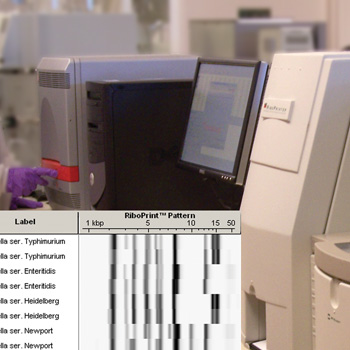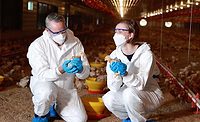Salmonella Serotyping in Poultry: Ready or Not, Here It Comes

Federal guidelines and Hazard Analysis and Critical Control Point (HACCP) programs established in the 1990s have produced mixed results when it comes to Salmonella contamination. The good news is that fewer people are getting sick—according to the Centers for Disease Control and Prevention (CDC), the incidence of Salmonella infection was down to 14.7 cases/100,000 persons in 2004, compared with 16/100,000 from 1996-1998. And infections caused by the main culprit, S. typhimurium, have decreased by 41% over the same years.
The bad news is that the food industry is a long way from meeting the U.S. Department of Health and Human Services Healthy People 2010 goal of 6.8 cases/100,000 persons. Additionally, the CDC reports that the incidence of infection caused by S. Enteritidis and S. Heidelberg has not changed much at all, while infection from S. Newport has increased by 41%, and infection by S. Javiana has climbed by a huge 167%. Also troubling is the increase in young chickens turning up positive for Salmonella—from 11.5% in 2002 to 13.5% in 2004.
Proposed Salmonella guidelines from the U.S. Department of Agriculture’s Food Safety and Inspection Service (USDA FSIS), aimed at reducing the incidence of these harmful pathogens in food, present new challenges for poultry processors. Meat and poultry samples that test positive for Salmonella will be further tested for the presence of specific serotypes associated with human illness. Because food safety programs will be judged by their ability to control those serotypes, processors will need a new level of Salmonella identification that allows them to reliably monitor their plants and processes.
Quick, Accurate Salmonella Detection
Many food companies around the world already rely on the BAX system from DuPont Qualicon for fast and accurate Salmonella testing of their food and environmental samples. In cases where Salmonella is indeed detected, how can poultry processors determine whether or not the bacteria are serotypes specified by FSIS as likely human pathogens?
Various phenotypic identification methods that use biochemical responses or fatty acid analysis to identify an organism provide only a genus-level name. To get to the serotype, labs must use either classical serology or a genetic method.
Traditional serologic methods typically require a large number of specialized reagents, along with skilled staff to perform the protocol and interpret the agglutination results, which can be very subjective. This classical serological approach is not very practical for routine identification in a large processing facility.
A genetics-based alternative is the RiboPrinter microbial characterization system from DuPont Qualicon. This system automates the Southern blot technique to generate and analyze genetic fingerprints (RiboPrint patterns) of bacteria. The patterns are digital representations of genetic information found in a sample’s DNA, specifically in the 16S, 23S, 5S, flanking and intergenic regions that encode ribosomal RNA. That data is then normalized and imaged as a barcode of light and dark bands.
By statistically comparing sample RiboPrint patterns to those in a database of more than 6,400 known standards for genus, species and serotype, the system can provide taxonomic identification of serotypes in about 8 hours.
The current identification database contains over 600 standard patterns for Salmonella serotypes of interest to the food industry. These were obtained from diverse sources, including food industry and government public health labs, as well as the ATCC and DSMZ culture collections. If a sample’s RiboPrint pattern does not match any of those, the pattern can be assigned to a custom identification database for future reference.
Beyond automated identification, the system also groups RiboPrint patterns according to their similarity. This powerful characterization feature analyzes genetic relatedness and allows for even greater discrimination by showing the slight differences in patterns among strains of the same serotype.
Each record can also contain associated historical data (where, when and why the isolate was obtained), which is useful for tracking the source and pinpointing the origins of contamination.
According to the Federal Register, the USDA-FSIS may intensify scrutiny of food companies that cannot control contamination with Salmonella serotypes of epidemiological concern. DuPont Qualicon offers a winning combination of products to help food labs proactively monitor their microbial environment—the BAX system for quick, accurate Salmonella detection, and the RiboPrinter system for reliable serotype identification with the benefits of automation, standardization and electronic data sharing.
qualicon.com
Looking for a reprint of this article?
From high-res PDFs to custom plaques, order your copy today!








